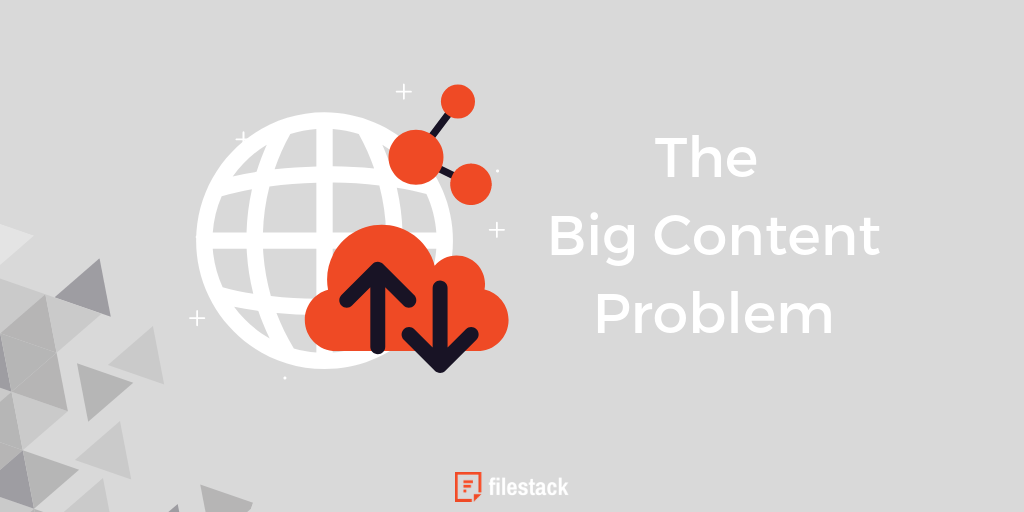A chill is in the air. The summer heat is a distant memory, as the wind blows colder and we put on our sweaters. Winter is here and as we focus on strategy for the next year, the weather is not the only change happening. As an organization that leads and supports the content industry, we’re witnessing another change that is crawling into every corner of the web.
Content is exploding exponentially. Users are armed with high-resolution multimedia creation machines in their pocket, with high-speed mobile bandwidth to handle what in past years would have been an absolutely reckless amount of data transfer, and it’s all aimed straight at you.
In 2017, of the roughly 7.5 billion people worldwide, each person took approximately 160 photos. In total, over 1.2 trillion digital photos were taken, which is a 100 billion photo increase from the previous year.
Big Content? I thought it was Big Data.
Content is how we describe the intentional presentation of data, so the two terms can get confusing. A blog post can be considered content. So can an image. But neither one of those just showed up by accident. The data used to generate that content can also be quite large.
You’ve heard of Big Data, but what is it really?
Big Data is the term used to describe a dataset larger than a single data management system’s “brain” is capable of holding at one time. Different techniques are needed to tackle this problem. Enterprise datasets have grown profoundly since the first days of the vacuum tube. The “Internet of Things” is generating a teeny, tiny tsunami of vast data constantly flowing to be stored. Users are generating content as they write, photograph and even video their way through life’s moments.
If I need to search a list of every file in any given system, how can I be sure to iterate through each one if the list is too big for the database management system to process? Big Data management techniques have made a science out of solving this problem. Usually, Big Data needs to solve a large number of files or fields, each of which can be quite large.
Big Content stretches into another dimension: the human experience. Content is growing in size, and faster every day. This growth in raw content and the ability for campaigns to effectively leverage User-Generated Content (UGC) to influence brand engagement is a goal all marketers share.
“Example.jpg”
Consider the humble JPEG. In the days of dial-up, its compression algorithm allowed us to exchange and store pictures with relative ease. The cameras of the day were measuring the number of pixels they captured during a photograph in Megapixels that could be counted on one hand. With affordable access to 4G LTE, even the most entry-level smartphones are capturing and uploading what would once have been considered massive files, with ease. Users are generating higher quality images as well as increasing the number of photos they snap, upload and share.
Photography is now second-nature to users around the globe.
Gone are the days of waiting for a roll of film to be developed and printed before finding out how many of the 24 carefully-timed photos of that special moment in your life even turned out visible at all. Content management systems have historically been very innovative, but the modern challenges are often focused on the routine work of catching up with the infrastructure, architecture and intelligence demands of production environments exploding with UGC.
The rise of the smartphone has introduced new challenges as it scales UGC to new heights. How do we ingest, digest and transform this massive stream of data into usable, consumable content?
So how does your organization deal with Big Content?
Let me ask that another way. How does your company deal with bigger and bigger content, with faster and faster demands from users? Your users aren’t slowing down. The average consumer spends 4.7 hours each day on their smartphones. They’re increasingly impatient with any distractions between them and the experience they’re seeking, and their attention span is shorter than ever. Google has coined a term for reaching these consumers through clear, concise “Micro-Moments” that deliver marketing messages in an interesting, highly condensed delivery.
I have a friend, whose father is a retired film producer, and he explained an important point to me that a 5-minute video is more expensive to create than a 15-minute video. Why? Because the work that goes into condensing content into a professional, concise delivery increases the more you have to make decisions about what to discard.
Like Michelangelo’s statues, your Micro-Moments are hidden inside of large file sizes that need everything-but-the-art to be carved away. An artist may be able to afford spending hours on a single piece of work, but that certainly will not scale to the massive needs of today’s UGC as Big Content takes over.
Automate the Heck Out of It
The answer is automation. Your content needs to go through a funnel that optimizes, categorizes, tags and transforms UGC at scale. It needs to be handled by your own robot army, faithfully reading the text in images with OCR, detecting faces, resizing, compressing, optimizing. We shouldn’t be intimidated by the rise of Big Content. After all, the same technology that has grown to allow content creation to scale provides us with everything we need to scale our content management as well.
Developers implement automation systems that support media, marketing, and UGC. Filestack is enabling them to do more with less by tapping into our massive upload, transformation and delivery systems with Machine Learning.
How will your organization handle the rising tide? Once you’ve got the technology in place, how will you scale? When a new technology emerges, how will you adapt?
Filestack is a dynamic team dedicated to revolutionizing file uploads and management for web and mobile applications. Our user-friendly API seamlessly integrates with major cloud services, offering developers a reliable and efficient file handling experience.
